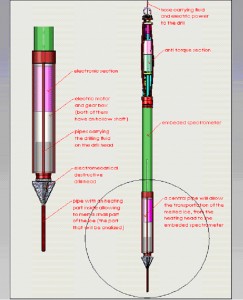- Share
- Share on Facebook
- Share on X
- Share on LinkedIn

Another rather technical development of the OF-CEAS technique was the realization of a very compact analyzer in the two transverse dimensions in order to allow its integration in the "subglacior" probe designed by our colleagues from the IGE laboratory, who obtained ANR and ERC funding for this project. The goal of this revolutionary probe is to measure the concentration of methane and the isotopic ratio of water along a 3 km thick borehole of an Antarctic glacier at Concordia station. This drilling would be possible in a record time of 3 months: the duration of the "warm" season.
The European Research Council (ERC), whose mission is to encourage scientific excellence in basic research in Europe, grants particularly innovative projects every year. In 2012, the ERC awarded a grant of 3 million euros to Jérôme Chappellaz, a researcher at the Institute of Environmental Geosciences and leader of the ICE&LASERS interlaboratory project. This project aims to reconstruct the evolution of climate and greenhouse gases by developing a new generation of instruments for the analysis of old polar ice in situ and in the laboratory. In 2010 and 2011, Jérôme Chappellaz had already received a grant from the BNP Paribas Foundation and the French National Research Agency for the design and production of a new type of laser probe capable of probing the memory of ice beyond one million years. This project, entitled Subglacior, is now an integral part of ICE&LASERS.
Revolutionizing paleoclimatology with a new probe
The aim of the Subglacior applied research project, the result of a partnership between the Institute of Environmental Geosciences, the LAME team of the Interdisciplinary Physics Laboratory (LIPhy, Grenoble), the Laboratory of Climate and Environmental Sciences (LSCE, Gif /s Yvette) and the Technical Department of the National Institute of Sciences of the Universe (DT-INSU, Brest) is to design, build and deploy in Antarctica a new type of probe to obtain the oldest climate records, beyond one million years, in a single field season.
The data will be measured over the entire ice thickness and will characterize the potential of the site as well as the variability of climate and atmospheric composition between 1,500,000 years and 800,000 years ago.
Objective and importance of the project for the international scientific community
The construction of this probe will solve a major technological and scientific problem for the study of climate. Between 1,500,000 and 800,000 years ago, marine records showed a radical change in climate variability, shifting from less intense but frequent ice ages (every 40,000 years) to longer, more pronounced ice ages (every 100,000 years). Extending the Antarctic records beyond one million years into the past is essential to understand the mechanisms, non-linearities and feedbacks of this major transition of the climate system, the most spectacular and the most recent.
This major climatic reorganization remains unexplained to this day because today, under current technological conditions, it is almost impossible to collect data older than 800,000 years. Ice this old can only be found in the bottom 10% of the Antarctic ice cap. However, the ice flow in the vicinity of the bedrock is complex and the choice of a site for heavy traditional drilling operations (raids, construction of a camp, 5 field campaigns, budget of about 30 million euros) is a major challenge.
Our in situ probe will be able to explore the deep polar ice and the coupling between Earth's orbit, climate and greenhouse gases during the last major reorganization of the climate system, in a single season. Climate models will finally be able to be confronted with precise empirical data on climate and CO2 concentrations over about 1.5 million years, and will give clues to explain the previous major climate change on our earth.
Mechanism of the probe
This revolutionary probe tackles major scientific challenges, thanks to an innovative technology and a consortium of 4 highly experienced partners from different research centers, from field work to the best scientific exploitation of the results. The principle of this probe lies in an innovative French laser technology allowing the measurement in real time of key parameters (water isotopes, concentration of air trapped in the ice in methane...) on an instrument embarked in a corer. Advances in near- and mid-infrared laser spectroscopy (OF-CEAS technique, patented by LIPhy) now allow to produce ultra-precise measurements on an instrument that is sufficiently compact and robust to be used in extreme conditions.After passing a first test at a depth of 600 m in the Mediterranean Sea in July 2014, the spectrometer is currently integrated into a next generation of the probe to be deployed on the Antarctic field in 2016/2017.
Actors
Erik KERSTEL
Daniele ROMANINI
Mechanism of the probe

- Share
- Share on Facebook
- Share on X
- Share on LinkedIn